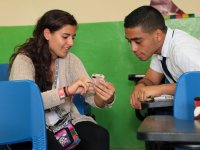20 Awesome BYOD and Mobile Learning Apps
Explore a wealth of tips and links for mobile learning apps that work across multiple platforms, an essential feature for running a BYOD classroom.
We have now been Bring Your Own Device (BYOD) for three years, and boy, do the students bring it. They bring it all! We have iPads, Surface, iPhones, Droids, Chromebooks, Macs, and PC laptops. Here's my current thinking. Please share yours in the comments section below.
Note Taking
If students can't find, review, and access their notes or pictures of the board, their mobile note-taking system is useless. There are two multi-platform frontrunners.
Microsoft OneNote
In my opinion, the most robust single note-taking app is Microsoft OneNote because it looks just like a traditional notebook. (The Learning Tools release in January 2016 have made it even more so.) It rocks interactive whiteboards because the notes you write on the board go directly into the notebook that you share with the students. You can also edit simultaneously. Students can write notes, grab screenshots, and make to-do lists. With lots of new features rolled out in the last few years, this app is the frontrunner for school note taking, in my opinion.
Evernote
Evernote is a multiplatform app, but you cannot edit simultaneously. It's compatible with the Livescribe Smartpen, which uses a tiny camera to scan every word written on Livescribe paper. Pencasts made with Livescribe are a fantastic flipped classroom tool.
The premium version searches handwritten text so that photos of the board or your notes can actually be found later. The new Reminders feature can help students remember what to review and study on a routine basis.
eBooks
With ebooks as the current battleground of education technology, students should know how to find and download ebooks and PDFs on Kindle, iBooks, and Kobo. (Google Play is must for Chrome or Droid.) Students should know how to take notes and search any reader that goes with their etextbook.
Writing
Traditional Essay Writing
For writing "traditional" essays, Microsoft Word is still a standby on Microsoft devices. Students are syncing personal documents through OneDrive. More iPad/Mac students are writing on their devices with Pages and then opening it at icloud.com.
My new favorite proofing tools include Grammarly (whose Chrome plugin is a must for every student web browser). I also love Hemingway for helping shorten sentences, and ProWritingAid for more advanced grammar and mechanics. You can save time when you use these tools.
Collaborative Writing
For collaborative, simultaneous writing and peer feedback, Google Drive/Docs is still king, although Office 365 has some new robust features that make Microsoft Word simultaneous even on the desktop. We couldn't do our team projects or online presentations without simultaneous word processors -- every school should choose one. Google Classroom has certainly made the management of collaborative documents much easier by including features that automatically share and unshare documents.
Moving Between Platforms
Students should know how to convert, export, import, and move data seamlessly between apps and devices of all kinds. They should also know how to print to epaper and how to open and annotate the documents in various readers. Zamzar is one of my favorite tools for this conversion process, and Calibre is a must-use for ebook conversion.
Blogging
Blog posts can often start in other programs, but I'm careful only to use apps that are completely compatible with blogs and RSS (Microsoft Word is notoriously not). I'd previously recommended Blogsy for iOS, Windows Live Writer for Microsoft, and MarsEdit for Mac, but Wordpress now has a solid app for blogging. Also, you could just have the students compose in Google Drive and paste into their blog editor.
Cloud Sync
One issue with mobile learning is how students will submit work. While we use OneDrive, Google Drive, and Dropbox depending upon the circumstance, Dropbox is my go-to workhorse because students can upload video or anything else. You can also link Dropbox with dropitto.me for students to turn in their work even if they don't have access to Dropbox.
Screenshots and Screencasts Are King (and Save Time)
No matter what platform, I want every student to know how to "grab" a screenshot. We use the Chrome plugin Snagit for just about everything, but Screencast-O-Matic is good for shooting quick videos. Not only is this a cyber safety protection skill, it's also great for turning in work from a mobile device when you just can't figure out how to export -- or when the interface is buggy (as many are).
Pulling It All Together: The LMS
The greatest level up in the past few years has been implementing our Learning Management system (LMS). We use Haiku Learning for all work. This year, it links with PowerSchool, which means that I enter grades just once and I'm pretty much done. No matter the device, every student can upload his or her work and receive feedback from me. I also teach students to set up notifications for teacher messages and properly turning in work, so they can handle problems quickly.
There are lots of LMS products out there -- just make sure that yours is multiplatform if you're in a BYOD environment.
If you've implemented BYOD or mobile learning, what are the most important lessons that you've learned? What are your favorite apps? Please share links to any blog posts that you've written about this rapidly emerging field and the reality of how these apps work.
